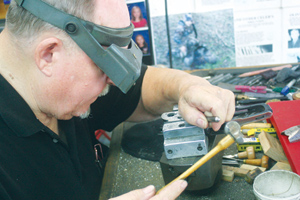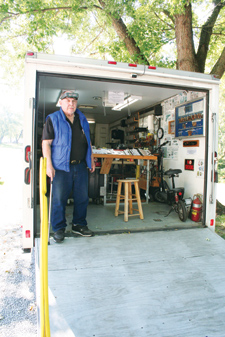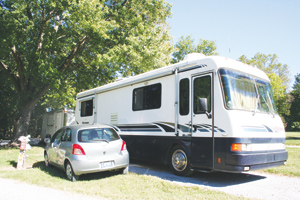Have Gun? Will Engrave!
Have Gun? Will Engrave!
 Growing up in the Everglades west of Fort Lauderdale, Florida, Bill Mains found his calling at age 16—and he’s never looked back. After apprenticing as a goldsmith and a watchmaker before the age of 18, he listened to people in the jewelry trade speak reverently about two hand engravers—Mr. Miller and Mr. Dongees. “That’s what I want to be,” he said.
Growing up in the Everglades west of Fort Lauderdale, Florida, Bill Mains found his calling at age 16—and he’s never looked back. After apprenticing as a goldsmith and a watchmaker before the age of 18, he listened to people in the jewelry trade speak reverently about two hand engravers—Mr. Miller and Mr. Dongees. “That’s what I want to be,” he said.
Following high school graduation, he swallowed his fear and hopped a Greyhound bus to Lancaster, Pennsylvania, carrying $500 borrowed from the Fort Lauderdale Ladies’ Aid Society in his pocket. “I enrolled at Bowman Technical School, one of only two schools for hand jewelry engraving in the United States, found a job at a gas station, and a place to live,” he recalls.“I worked nights and set a record by finishing the school’s eight-month self-advancement course in two and a half months. I had no money, so I had to get going!”
At the height of the Cold War, Bill was drafted into the Strategic Air Command of the United States Air Force. “I had learned to engrave jewelry and never thought about anyone wanting a gun engraved. But in the Air Force, I discovered that weapon engraving goes back thousands of years,” he says. “Man’s most valuable possessions were always his weapons of defense, and I understand that 3,000 years ago, the Chinese engraved their swords and shields.”
As ironic as it sounds, the current recession has increased Bill’s workload. “”People keep shoving guns and money at me,” he continues with laugh. “It’s been that way for me in every recession in the last half century. Gun owners with money are not going to invest now in the stock market. But they will upgrade a gun. They get a good investment and instant gratification.”
Bill Mains has a world-wide reputation for quality, custom gun and accessory engraving solutions of all scales. One of the last of the old school American Hand Engraving Artists, he uses only hammers and chisels at a workbench in his mobile workshop pulled behind his motorhome. When he moves from one skeet or sport shooting event to another, his workbench rolls to the back of the trailer, and his Toyota goes inside.
Bill creates artistic hand engravings. His partner, who maintains their brick and mortar shop in Indiana, does the inscriptions or names engraved on a gun. In their shop, they also manufacture sterling silver buckles and money clips—trophies for the shotgun tournaments.
In 1959, after his discharge from the Air Force, Bill invented the rotary foot wheel engraving bench, a device, resembling a potter’s wheel with a lathe chuck on top. His invention enables him to be one of the fastest engravers in the world.
“People ask, ‘How is that moving—with your wrist?’” “No,” he answers. “The right foot is the motor; the left foot’s the brake. The piece I’m engraving is rotating, but my hand stays still.”
“No,” he answers. “The right foot is the motor; the left foot’s the brake. The piece I’m engraving is rotating, but my hand stays still.”
Prior to living full-time on the road, Bill engraved from 1967 to 1972 for Colt’s Manufacturing Company, gaining the distinction of engraving more second generation Single Action Army revolvers than anyone else.The company frowned on signing engravings; yet, because Bill worked on contract out of Buffalo, New York, most of his factory engraved colts are stamped with a small buffalo under the cylinder pin. Among other gun manufacturers, Bill contracted work for the Ithaca Gun Company, engraving all of their single barreled trap guns, and many others, during the last eleven years of their production.
He and his partner continue to engrave over 100 guns annually for the New Ithica Gun Company. “They make this 28-guage pump gun, which is a bird gun,” Bill says. “Two and a half years ago, I designed the prototype. After I did the engraving, I digitized all the work and e-mailed it to my partner. He now precuts the design on a computerized machine, saving me two-thirds of my time. Between the two of us, we finish the guns.”
After living and working many years in New York, Bill set up shop in Las Vegas for 27 years. He engraved jewelry and other pieces for numerous celebrities including Elvis Presley, Liberace, and Liberace’s brother, George, Shirley McClaine, Wayne Newton, George Foreman, Buddy Hackett, Frank and Barbara Sinatra, and Stephen Spielberg, to name a few.
Bill eventually found his Beaver coach and he says its Caterpillar engine does not even know a trailer-workshop with a car inside is hitched behind. Inside his coach, he carries two computers—one totally assigned to graphic art, the other dedicated to broadband Sprint Internet. He produces his own catalogs and brochures, and often intricate designs and plans for his engravings. One chair had to go to make room for his large laser printer and its cabinet; otherwise, his office space fits on the dinette.
“A 30-foot rig is comfortable for one person,” he says. “The closet space is not adequate for two. I don’t collect things; and I use throw-away dishes.” Bill basically lives at gun clubs—booking his vendor space at trap, skeet, and sporting clays shoots six months to a year in advance. He says some shoots last three days—others, 10 or 12 days. He generally arrives a day or two early and stays a couple of days after the event, planning his schedule for San Antonio during October and November; Florida from December through March; Nashville in April; and Pennsylvania and Ohio in May and June. At his Indiana shop, he pulls in for a month or so and plugs in outside the building
Bill basically lives at gun clubs—booking his vendor space at trap, skeet, and sporting clays shoots six months to a year in advance. He says some shoots last three days—others, 10 or 12 days. He generally arrives a day or two early and stays a couple of days after the event, planning his schedule for San Antonio during October and November; Florida from December through March; Nashville in April; and Pennsylvania and Ohio in May and June. At his Indiana shop, he pulls in for a month or so and plugs in outside the building
“A lot of my work is done at the gun clubs. I can hand the finished engraving back to the client on the spot,” he says. However, he explains that he receives phone calls and e-mails from all over the English-speaking world, and he usually has at least a month’s worth of work in his mobile shop at all times.
“I’m considered the grip-cap guru of the world,” he says. “A grip cap is the most popular item among gun owners. With a distinctive grip cap, the gun owner immediately recognizes his or her gun in a rack.”
Bill explains that once someone contacts him for a grip cap, he sends out a kit so he can make a plaster cast that matches his particular gun. Some orders come from England, Scotland, New Zealand, and Australia. “When I receive the cast, I make the grip and ship it back to them,” he says. Inside his mobile workshop, he displays a poster with various grip cap designs.
He orders supplies and shipments arrive at various addresses of gun clubs on his circuit. For example, he never knows if he will need sheets of gold or gold wire, so he orders casting grain, and melts down the little gold nuggets to make what he needs.
Taking his business on the road suites Bill Mains. He earns a good living doing what he loves best. As a bonus, he meets thousands of interesting people in the shotgun sports. “At the shoots, they are just Pete, John, and Joe,” he says. “But most are professionals—federal judges, dentists, doctors, entertainers, or corporate owners—because it takes money to play the game.
“I don’t miss mowing grass or patching roofs. I stay busy with a creative profession, and when I want to visit my daughters—one in Tennessee and one in New Mexico—I take my home and my workshop with me. Otherwise, I live like a normal person!”


